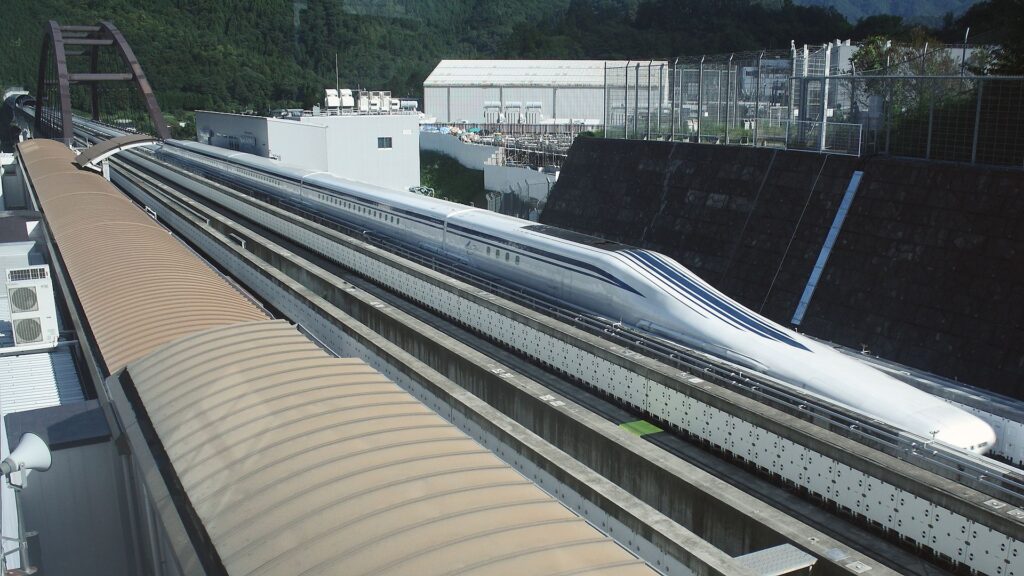Facts about the Maglev train! You’ll be surprised to know this not-so-romantic blog is filled to the brim with facts about the Maglev. Or is it? (Let’s face it- this could be clickbait)
Technology is ever-changing. Less than 100 years ago we were still travelling on mostly horse-drawn vehicles. Then the world adopted the steam locomotive which dominated travel for 130 years. Next came diesel and now we have electric-powered trains but what is next for the railways?
As passengers we want to go faster, have more reliable services and honestly have cooler-looking trains. Plus- speaking for the taller amongst us- DECENT LEG ROOM!
For me, one of the coolest trains is the Maglev, which stands for magnetic levitation or as I often call it- the magnet-powered train.

A Maglev train works with two sets of magnets. One set is used to lift the train up and suspend it on a magnetic field, if you want to get technical about it, this is repulsion- when two magnets push away from each other.
The second set of magnets is used to push and pull the train in a certain direction- forward and backward. The side of the train is lined with magnets and there are more magnets lining the side of the track.
For further information. Magnets have two poles. One is called north and the other south. If you put a north pole of a magnet next to the south pole of another magnet they will stick together. We call this attraction. But put a south pole to a south pole or a north pole to a north pole they push apart. We call this repulsion.
It’s this very basic principle that gives the maglev its power.
The magnets on the side of the track have their poles quickly changed which means that at first, they pull a magnet on the side of the train towards them, and then quickly repel them- this is happening for every single magnet. The quicker these magnets are able to change poles- the quicker the maglev train will go.

Because it is floating the maglev can take advantage of there being no friction. Just in case you aren’t aware, friction is the force between two surfaces. If you try and run on ice in your trainers it is very difficult as there’s not a lot of friction between your shoe and the ice.
Counter to this if you tried to ice skate on sand- it would be very very difficult.
The maglev has no friction- which means there’s no resistance to slow down the train. The lack of friction also helps with the sound pollution of the maglev. No friction means these high-speed trains travel almost silently with an incredibly smooth ride for the passengers as well.
joke time
We interrupt our regular not-so-romantic blog post for a quick joke from our author.
We all know where magnets grow right? Magnetic fields – funny right?

Moving on… it’s time for some facts about the Maglev train.
Birmingham
The first commercial maglev was actually in Britain. It opened in 1984 and ran between Birmingham airport and the International railway station at an eye-watering speed of 25 miles per hour! It closed in 1995 due to technical problems and was replaced by a bus.
Talk about going backwards.

Insanely fast
Japan is currently developing and testing new maglev technology and hopes to have it in full operation by 2027. To put into context how much maglevs will speed up travel, the distance between Japan’s capital, Tokyo, and the city of Nagoya is 218 miles. If you jumped in your car, there was no traffic and you got lucky with traffic lights you could drive there in about five hours.
The maglev train will take 40 minutes. That’s 4 hours and 20 minutes faster than driving. That’s what high-speed travel actually looks like.
L0 Series Maglev
Whilst we’re on the subject of speed the fastest maglev to ever have run is the L0 series maglev in Japan. When on a test track run it hit a top speed of 374 miles per hour.

they’re only going to get quicker
Still sticking with the speed theme- it’s reckoned in the next 5 years maglev trains will be able to travel at 550 miles per hour. That’s definitely fast travel.
Crikey- those were some speedy facts about the maglev train.
cheap to maintain
Compared to a lot of other railway rolling stock, maglevs are cheaper to maintain. Because they don’t rub on rails the equipment used doesn’t wear out as quickly. As a counter to this, they do cost a mind-melting amount to set up and build from scratch. Basically, all the new maglev routes would have to be built from scratch as they can’t use traditional rails.
wider
Maglev trains are wider than the carriages you would travel on in the UK. This allows for more comfort and ease of travelling- including more legroom!
no wheels
A maglev doesn’t have any wheels- it’s floating so has no use for them. This does mean it’d be a pretty bumpy landing if the magnetic field was turned off. They are only floating around 10 centimetres above the track anyway so at least it wouldn’t be a long fall.
environment friendly
To round out these facts about maglev trains I thought I’d let you know that maglev trains are a lot more efficient than other modes of transportation and don’t pump nearly as much carbon dioxide into the atmosphere.
Not to brag- but I really like these fun facts about the maglev trains. I hope you did as well!
What to read next
If you’ve enjoyed this not-so-romantic blog and the facts about the maglev train, then be sure to check out the blogs below.
If you enjoy learning about the railways then check out my book: The not-so-romantic railways.
